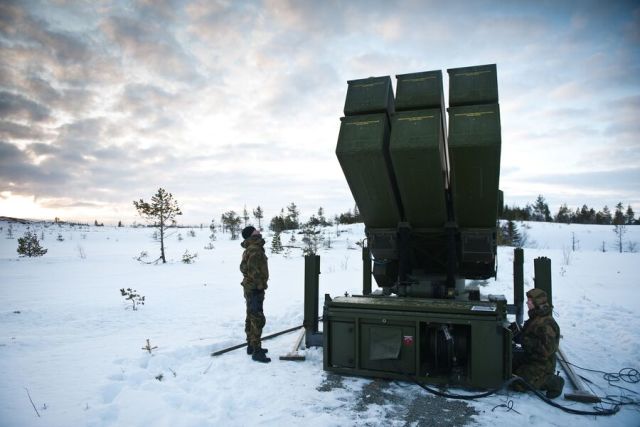Washington has found anti-aircraft missile systems for Ukraine in the Middle East The United States has begun negotiations with the countries of the Middle East on the transfer of the NASAMS air defense system to Ukraine to provide anti-aircraft cover for the main administrative and political centers of the country.
"Newspaper.Ru" dealt with the details of the issue.
In November, the Pentagon announced that it had sent eight NASAMS anti-aircraft missile batteries to Ukraine. In the same month, US President Joe Biden allocated another $400 million package of military assistance to Ukraine. It included, among other things, anti-aircraft guided missiles for the NASAMS air defense system, since a significant number of missiles of this type were used up during previous hostilities in Ukraine.
In addition, the United States Army has signed a contract with RaytheonMissiles and Defense for up to $1.2 billion for the supply of six more NASAMS air defense systems for Ukraine.
The contract is part of the fifth package of the Ukraine Security Assistance Initiative (USAI) and includes training and logistical support for the Armed forces of Ukraine.
Raytheon (the second largest corporation in the world in terms of production of weapons and military equipment) in August won a contract for the supply of NASAMS anti-aircraft missile batteries for the Armed Forces of Ukraine as part of the third USAI package. The new contract is, in fact, a continuation of previously concluded agreements.
The first two NASAMS batteries capable of launching advanced AIM-120 medium-range missiles were delivered, deployed and, according to Pentagon officials, "successfully demonstrated the effectiveness of this type of SAM against modern means of air attack."
The NASAMS air defense system was created by the Norwegian defense company Kongsberg Defense & Aerospace in cooperation with Raytheon Corporation. SAMs of this type are currently used for anti-aircraft missile cover of the US Federal District of Columbia from possible threats from the air, but otherwise NASAMS are not used in operations and combat operations of the US Ground Forces.
It usually takes 24 months to produce and deliver NASAMS air defense systems to the customer, although the US Army and the American defense industry are looking for ways to shorten this period.
"These efforts once again illustrate the urgency that the US government is showing in its approach to acquiring air defense systems for our allies and replenishing our own stocks of weapons and military equipment," the US Army said. These words are quoted by Defense News
"The rapid conclusion of a contract with Raytheon Missiles and Defense in the amount of up to $1.2 billion for the supply of six NASAMS air defense systems for Ukraine is another example of the ability of the US Armed Forces to accelerate the delivery of critical means of warfare through US industry partners to our allies," added Doug Bush, head of the US Army Supply Department.
The work on the conclusion of the contract with Raytheon was led by the Office of the US Armed Forces Guided Missile and Space Program, as well as other representatives of the US Department of Defense.
At the same time, NASAMS air defense systems, in accordance with the contract with Raytheon, can be transferred to Ukraine only by 2025 (we are talking about six anti-aircraft missile batteries consisting of 72 launchers).
For these reasons, the United States began negotiations with the countries of the Middle East on the transfer of NASAMS air defense systems (previously delivered to these monarchies) for the Armed Forces of Ukraine to provide anti-aircraft missile cover for the main administrative and political centers of Ukraine. Washington promises to compensate for such supplies to the countries of the Middle East within six months. There is every reason to believe that the Gulf monarchies and Oman will not be able to refuse this offer. And the corresponding systems with the help of US military transport aviation will be transferred to the eastern regions of Poland in a fairly short time, and then to Ukraine.
It is quite possible that in addition to NASAMS, Oman can send the Pantsir-S1E missile defense system to Ukraine, Qatar - the Roland air defense system, Bahrain (and this country can easily connect to the transfer of weapons and air defense equipment to Ukraine) - the MIM-23 Hawk and Krotal air defense systems.
Meanwhile, Ukraine has requested from the West a comprehensive anti-aircraft and non-strategic missile defense system, which the United States and Washington's other allies in the North Atlantic Alliance seek to implement for Kiev in a fairly short time. The system will consist of anti-aircraft missile systems and short-range, short-range, medium-range and long-range air defense systems, which together should effectively neutralize threats from Russian manned aviation and cruise missiles of all types based.
According to Western analysts, at the moment, the armed forces of Ukraine mainly use Soviet-made anti-aircraft missile systems and systems. In addition to the NASAMS air defense system, Ukraine has also requested (and is already receiving) The Hawk air defense system of the Cold War, which is still considered an effective system and allows you to solve most of the problems that arise during the repulse of air attack attacks currently used in armed conflict.
It will certainly take a very long time to deploy a comprehensive non-strategic missile defense system in Ukraine. But the process is already running. The whole question at present is only the timing of the implementation of the announced program.
Mikhail Khodarenok

